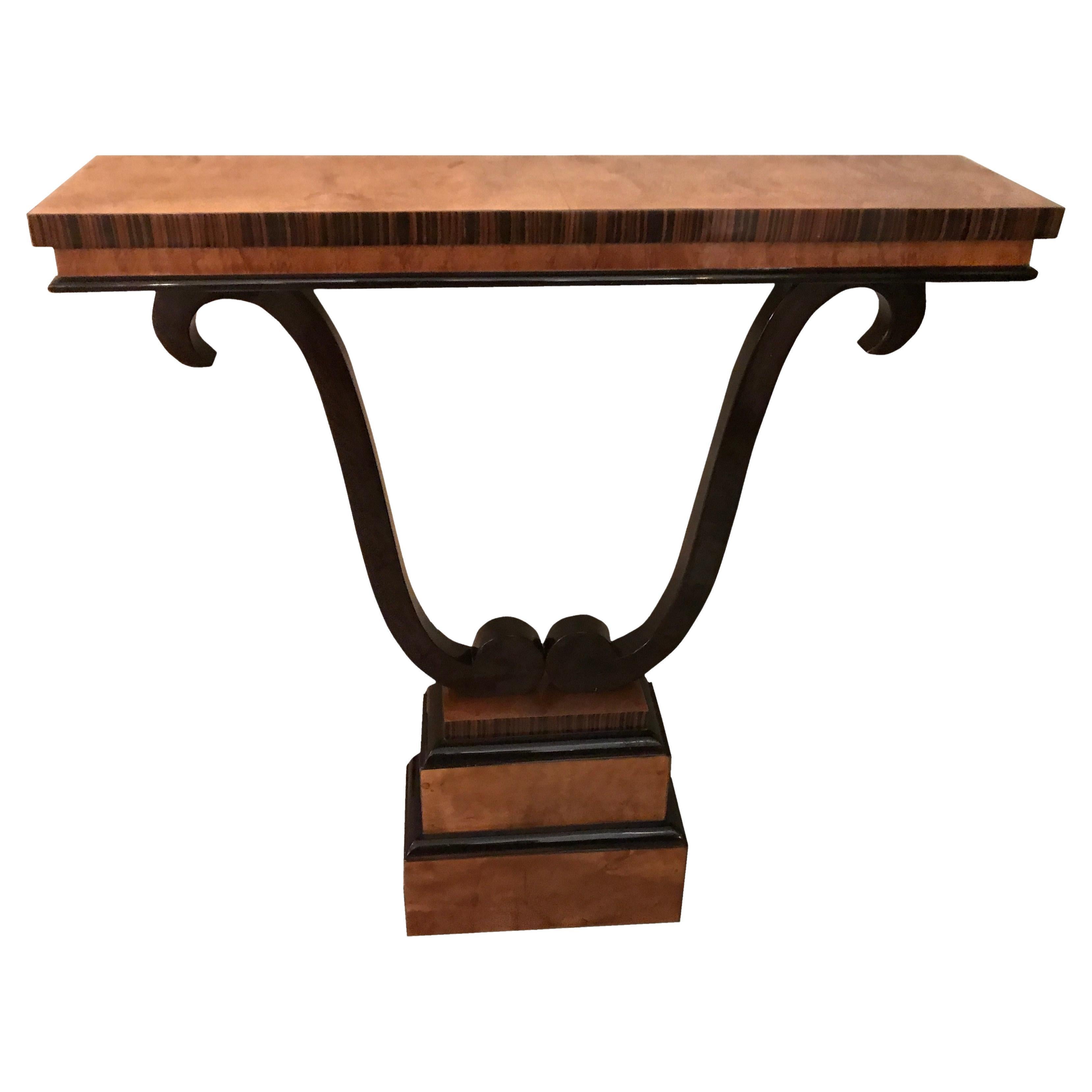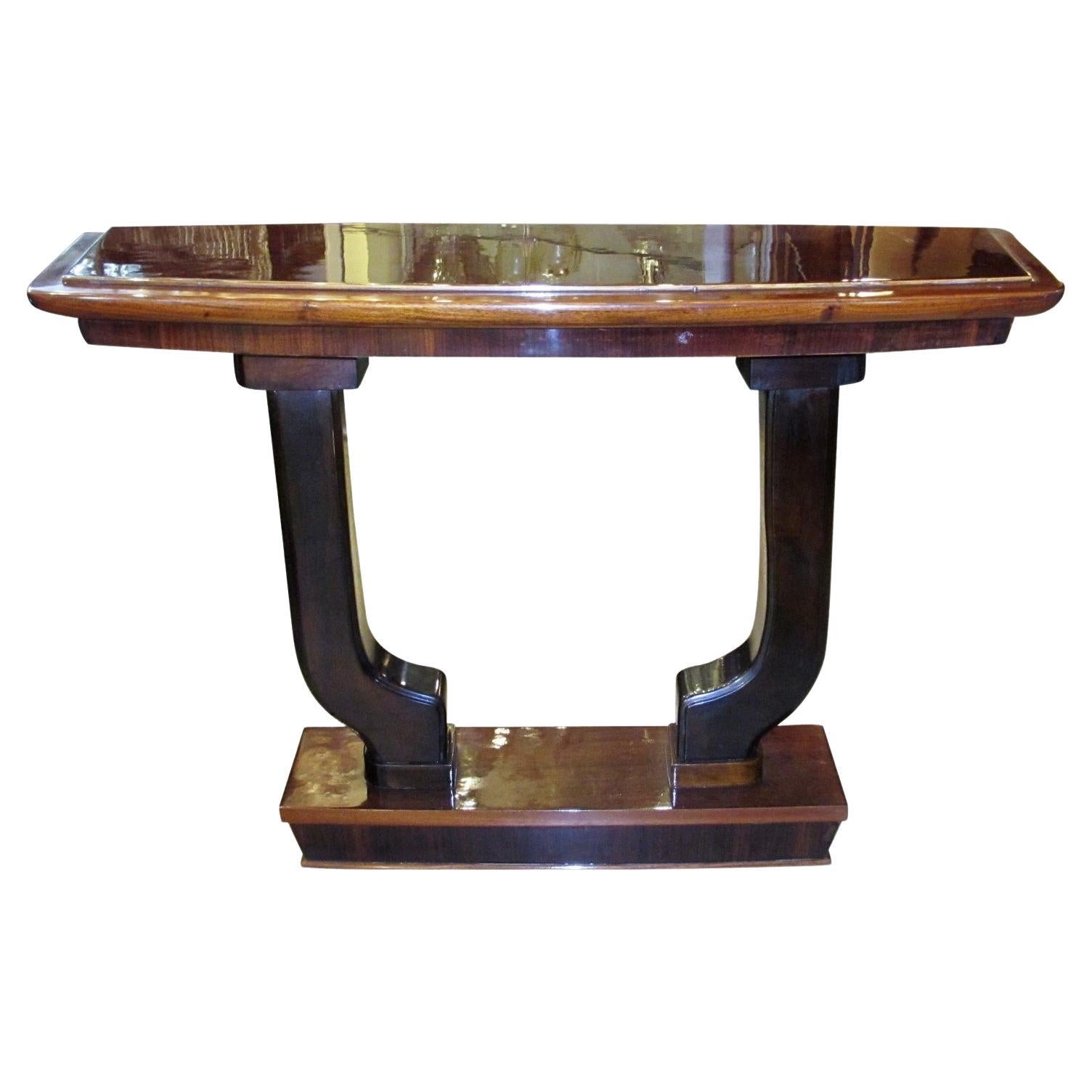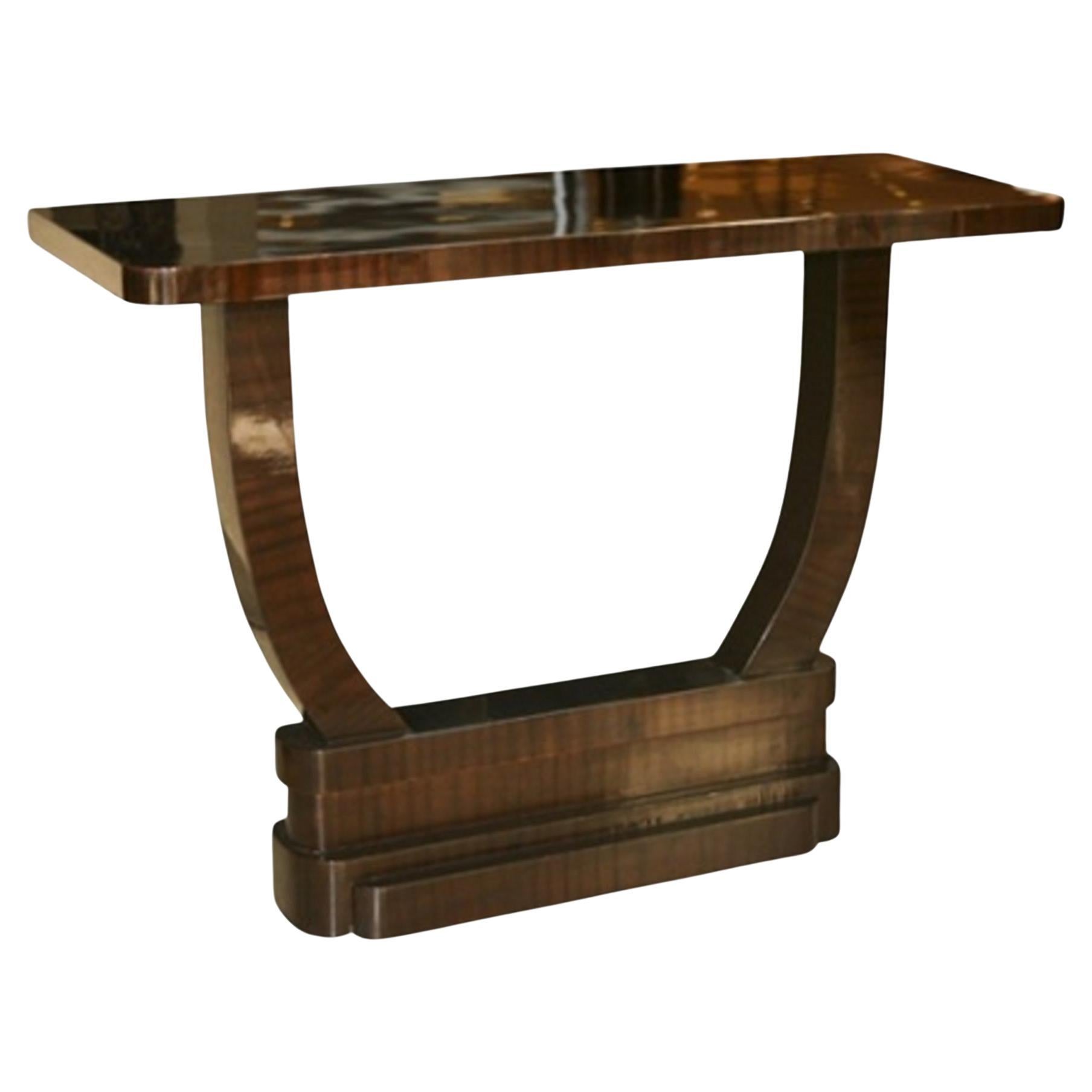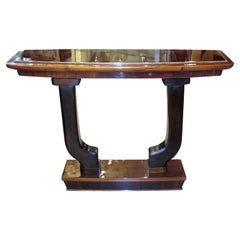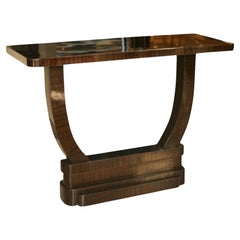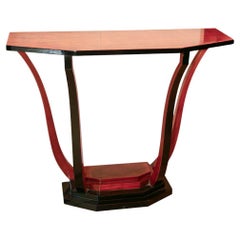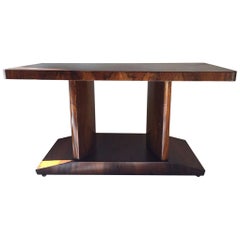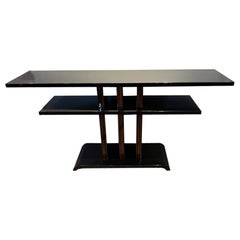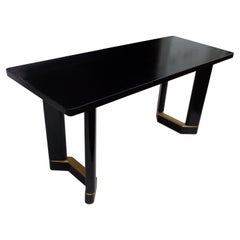Items Similar to Console in Wood , Style: Art Deco , 1940
Video Loading
Want more images or videos?
Request additional images or videos from the seller
1 of 17
Console in Wood , Style: Art Deco , 1940
$13,500
£10,104.55
€11,675.93
CA$18,720
A$20,968.80
CHF 10,901.45
MX$258,922.54
NOK 138,875.86
SEK 131,285.52
DKK 87,132.15
Shipping
Retrieving quote...The 1stDibs Promise:
Authenticity Guarantee,
Money-Back Guarantee,
24-Hour Cancellation
About the Item
Console Art Deco
Material: Wood and glass and gold
Comte (1932-1960) was a design house and the most important manufacturer and importer of furniture and decorative objects in Argentina during the middle of the 20th century. Comte produced furniture in both the English and French styles of the 19th and 20th centuries.1
1932-1936: Training and early years
The Comte company was founded in 1932 by Ignacio Pirovano, his brother Ricardo Pirovano and the architects José Enrique Tívoli and Mariano Mansilla Moreno. Later, Celina Pirovano, also an architect and wife of Ricardo Pirovano, would join Comte.2 The main creative force behind Comte was Ignacio Pirovano, who in turn was inspired by Jean-Michel Frank, whom he met in 1920, and his gallery located in Paris on his constant trips to this city. Ricardo Pirovano acted as president of the company and managed the administrative part of the company.3
During its first four years of existence, Comte was located at Avenida Roque Sáenz Peña 1129 and was dedicated to the import, execution and sale of fine furniture and decorative accessories,2 among which were found many pieces of European origin, for later sale. sale to his high society clientele in Buenos Aires.
1936-1942: Company growth
On March 30, 1936, the company moved to 10792 Arenales Street and signed an exclusivity agreement with Jean-Michel Frank to produce his designs in the country.3 The French designer served as artistic director of the company. for an indeterminate period.3 At this stage the company specializes in furniture and decorations, carpets, wood coverings and in general everything related to the authorization of the most important works of large departments of the State, public and private companies, both from the country as well as from abroad.2 As examples we can mention the Llao Llao Hotel in Bariloche, Argentina, the Mar del Plata Casino, in Mar del Plata, Argentina and the Banco de la República del Paraguay in Asunción, Paraguay.
During that period, several studios were opened: the first in 1937 located at 1164 Segurola Street, the second at 451 Paramaribo (current Fragata Sarmiento Street), quickly followed by new addresses at 1281 Avellaneda, 1536/40 Paseo Colón Avenue, 535 Darwin /43, Francisco Acuña de Figueroa 855 and Deán Funes 1832.2 This reflects the incredible growth of Comte and the company's production capacity. In 1939 Comte moved to 953 Florida Street, where it had an exhibition hall and sales to the public.2
1942-1960s: Expansion into other areas and final years
On April 27, 1942, Comte was officially transformed into a Public Limited Company, with an authorized capital of m$n 600,000. For that year, it occupied the imposing premises on 936/40 Florida Street, where it would operate until the end of 1954, when it moved its commercial address to 1832 Deán Funes Street, where it had its industrial establishment.2 By 1946, it centralized all its operation in this last address, to which another location was added located at 1877.2 Luca Street. Consequently, with the experience acquired by organizing its aeronautical section and when the contracts corresponding to this section were suspended, it dedicated itself to preparing its plant for the lines of wooden cabinets in series specializing in cabinets for T.V., radios, transistor radios, combined, stereophonic, tables for sewing machines, among others.2
The company finally closed its doors sometime in the 1960s after the death of one of its founders, Ricardo Pirovano.
Commercial items used
Three types of commercial items were used by Comte: COMTE S.R.L., COMTE S.A. and COMTE S.A.I.yC. Initially the company was formed as an S.R.L. in the year 19322 (Limited Liability Company) dedicated mainly to the import of furniture from Europe. Around 1937, Comte expanded and formed a second company under the name S.A.2 (Sociedad Anónima) that would be used mainly for the manufacture of furniture and decorative objects under the exclusivity of both national artists (such as Alejandro Bustillo) and international artists ( like Jean-Michel Frank). From 1937 to 1942 both S.R.L. companies. and S.A. They coexisted. In 1942 the company S.R.L. ceased to exist and only the company S.A.3 remained active. The records indicate that COMTE S.A. It had its first workshop in 1937 at 1164 Segurola Street and its official institution was carried out on April 15, 1942. This explains the fact of the existence of receipts and other documentation issued by Comte listing pieces with identifications "COMTE S.A." and "COMTE S.R.L." in the same period of time.1 Since 1946, the company S.A. It also coexisted with the S.A.I. and C. (Industrial and Commercial Public Limited Company).1
List of the most important works carried out
Presidency of the Argentine Nation
Presidential Residence in Capital Federal, Argentina.
Presidential Estate in Olivos, Argentina.
Ministry of War
(now called Ministry of Defense)
New Ministry building.
Olivos Military Spa.
Officers' Casino and Barracks in Convunco Centro.
Various barracks dependent on the General Directorate of Engineers.
Ministry of Aeronautics
General Secretariat of Aeronautics.
D.L. – D.L. 22; complete fuselages.
Ministry of Interior
Charity Lottery – Mar del Plata Club Annex., Buenos Aires, Argentina.
National Parks
Hotel "Llao-Llao", Nahuel Huapí National Park, Bariloche, Argentina.
Embassies
Argentine Embassy in Lima, Peru.
Embassy of Peru in Buenos Aires, Argentina.
Embassy of Spain in Buenos Aires, Argentina.
U.S. Embassy in Buenos Aires, Argentina.
Others
Bank of the Republic of Paraguay, Asunción del Paraguay.
Circle of the Union of Peace, Bolivia.2
We have specialized in the sale of Art Deco and Art Nouveau styles since 1982.If you have any questions we are at your disposal.
Pushing the button that reads 'View All From Seller'. And you can see more objects to the style for sale.
Why are there so many antiques in Argentina?
In the 1880 – 1940 there was a grate wave of immigration encouraged by the periods of war that were taking place.
1st World War took place between 1914 and 1918
2nd World War took place between 1939 and 1945
The immigrants options were New York or Buenos Aires. Tickets were cheap and in Buenos Aires they were welcomed with open arms, as it was a country where everything was still to be done.
Argentina was the country of new opportunities, labour was needed and religious freedom was assured, in many cases the of the family travel first until they were settled and then the rest of the family members join them.
In the immigrant museum “Ellis Island Immigrant Building” in New York you can se the promotional posters of the boats that would take them to a new life.
Between the years 1895 and 1896, Argentina had the highest DGP (gross domestic product) per capita in the world according to the Maddison Historical Statistics index, this situation arose due to the large amount of food being exported to European countries, which were at war.
The Argentinean ships left the port of Buenos Aires with food, but they returned with furniture, clothes and construction elements, (it´s common to see this the old buildings of the historic neighbourhood of San Telmo, the beams with the inscription “Made in England)”, as well as many markets that were built in Buenos Aires, such us the San Telmo Market, whose structure was brought by ship and afterwards assembled in 900 Defensa Street.
With the great influence of European immigrants living in the country, the children of the upper classes travelled to study in France, resulting in the inauguration of “La Maison Argentinienne”, on 27th of June 1928, in the international city of Paris, which hosted many Argentinians that were studying in Frace.
It´s the fourth house to be built after France, Canada and Belgium, being the first Spanish-speaking one. Still in place today (17 Bd Jourdan, 75014, Paris, France). Many of the children of these wealthy families who attended international art exhibitions, museums and art courses abroad, took a keen interest in the European style. This is why Buenos Aires was at the time referred as “The Paris of South America”.
Between the years 1890 and 1920 more than a hundred Palaces were built on Alvear Avenue the most exclusive avenue in Buenos Aires. Today some of these palaces have been transformed into museums, hotels and embassies.
In the year 1936, the Kavanagh building was inaugurated, it was the tallest reinforced concrete building in South America.
During 1994 the American Society of Civil Engineers distinguished it as an “international engineering milestone”, and it´s now considered a World Heritage of Modern Architecture.
At the time was common to hire foreign architects such as Le Corbusier, who visited Buenos Aires/Argentina in 1929 and in 1948 he drew up the blueprints for a house built in La Plata City (which was declared a World Heritage Site).
In 1947, the Hungarian architect Marcelo Breuer designed “Parador Ariston” in the seaside city of Mar del Plata. After an Argentinean student at Harvard University convinced him to come to Argentina. He worked on an urban development project in the Casa Amarilla, area of La Boca.
The Ukrainian architect, Vladimiro Acosta, arrives in Argentina in 1928 and worked as an architect until que moved to Brazil.
Antonio Bonet, a Spanish architect who worked with Le Corbusier in Paris, arrives in Argentina in 1937, where he carried out several architectural works and in 1938 designs the well-known BFK chair.
Andres Kálnay, of Hungarian origin, made around 120 architectural masterpieces, among which the former Munich brewery stands out, he even made the furniture’s design.
The German architect, Walter Gropius, director of the Bauhaus, lived in Argentina, where he wrote articles for “Sur” magazine and founded in Buenos Aires, an architectural firm with Franz Möller, who was also an architect, where he built two houses.
At the same time several famous designers decided to immigrate to Argentina, among them we can find the well-known French designer, Jean-Michel Frank, who arrived in the country in 1940 and also worked for the Rockefeller family.
Special pieces were made, which were sold exclusively in the country, such as the well-known German company “WMF”, who sold their products by catalogue, which were chosen by the ladies of high society in the list of wedding gifts, as well as the pieces designed by Christofle.
The Swiss sculptor Alberto Giacometti, made special pieces for Argentinean mansions.
In 1904 the first Jansen branch outside Paris was established in Buenos Aires, as the Argentinean clientele demanded a large amount of furniture, from the end of the 19th century to the mid-20th century.
In 1970, the brand Rigolleau Argentina made pieces authorised by Lalique.
The brands Maple and Thompson also set up shop in the country.
The French plastic artist, Marcel Duchamp moved to Argentina in 1918-1919.
Glass signed Gallé, Charder, Leverre, Schneider, Muller and other French firms. They were bought in flower shops and were given to ladies with beautiful floral arrangements.
Some furniture manufacturers travelled to international fairs and bough the patterns to produce the furniture in Argentina, such as the furniture firm Englander and Bonta, who bought the patterns ins Italy.
It is worth mentioning that in Argentina we have the largest community of Italians outside of Italy, as it is estimated that 70 percent of the inhabitants have at least one Italian descendant, followed by Spanish immigrants.
The most Important furniture stores in Argentina:
Comte is founded in 1934 (under the direct management of Jean Michel Frank in 1940).
Nordiska (Swedish company established in 1934).
Churba in 1960, a company that brought foreign designers to present their furniture in the country:
Denmark: (Arne Jacobsen, Finn Juhl, Bender Madsen, Ejner Larsen, Poul Kjaerholm, Hans Wegner)
Sweden: (Hans Agne Jakobsson, Gustavsberg)
United States: (Herman Miller)
Finland: (Lisa Johansson, Folke Arstrom, Tapio Wirkkala, Alvar Aalto, Timo Sarpaneva)
Swedish Factory: (Orrefors)
Italy: (Littala, Vico Magistretti, Emma Gismondi, Gae Aulenti, Angelo Mangiarotti, Elio Martinelli, Gianna Celada, Angelo Mangiarotti, Mario Bellini, Carlo Scarpa)
Finland: (Olivia Toikka)
Plata Lappas (Lappas Silver): a goldsmith shop founded in 1887 in Argentina by Alcibiades Lappas of Greek origin.
In 2019, in Argentina took place “the Art Deco world congress”, in which we participated as hosts invited by Geo Darder, founder of the Copperbridge – Foundation, in which prominent people from all over the world attended to learn about Art Deco in Argentina.
Argentina currently has more than 100 Art Deco buildings and another 90 Art Nouveau buildings throughout the city of Buenos Aires.
Argentina is a country that has not been involved in many wars, which is why it has been a refuge for works of art and antiques from different periods of time, unlike European countries. That is way many collectors, museums and antique dealers from all over the world visit it, you should not miss the opportunity to visit this great country.
Laura Guevara Kjuder, architect.
- Dimensions:Height: 30.32 in (77 cm)Width: 51.38 in (130.5 cm)Depth: 21.86 in (55.5 cm)
- Style:Art Deco (Of the Period)
- Materials and Techniques:
- Place of Origin:
- Period:
- Date of Manufacture:1940
- Condition:Refinished. Wear consistent with age and use.
- Seller Location:Ciudad Autónoma Buenos Aires, AR
- Reference Number:Seller: F-TO-6371stDibs: LU6785237564122
About the Seller
5.0
Vetted Professional Seller
Every seller passes strict standards for authenticity and reliability
Established in 1982
1stDibs seller since 2022
36 sales on 1stDibs
Typical response time: <1 hour
- ShippingRetrieving quote...Shipping from: Ciudad Autónoma Buenos Aires, Argentina
- Return Policy
Authenticity Guarantee
In the unlikely event there’s an issue with an item’s authenticity, contact us within 1 year for a full refund. DetailsMoney-Back Guarantee
If your item is not as described, is damaged in transit, or does not arrive, contact us within 7 days for a full refund. Details24-Hour Cancellation
You have a 24-hour grace period in which to reconsider your purchase, with no questions asked.Vetted Professional Sellers
Our world-class sellers must adhere to strict standards for service and quality, maintaining the integrity of our listings.Price-Match Guarantee
If you find that a seller listed the same item for a lower price elsewhere, we’ll match it.Trusted Global Delivery
Our best-in-class carrier network provides specialized shipping options worldwide, including custom delivery.More From This Seller
View AllConsole in Wood , Style: Art Deco , 1920
Located in Ciudad Autónoma Buenos Aires, C
Console Art Deco
Material: Wood
Comte (1932-1960) was a design house and the most important manufacturer and importer of furniture and decorative objects in Argentina during the mid...
Category
Vintage 1920s French Art Deco Console Tables
Materials
Wood
Console in wood, French 1930, Style: Art Deco
Located in Ciudad Autónoma Buenos Aires, C
Art Deco
Year: 1930
Country: French
Wood
Finish: polyurethanic lacquer
It is an elegant and sophisticated console.
You want to live in the golden years, this is console that your pr...
Category
Vintage 1930s French Art Deco Console Tables
Materials
Wood
Console in Wood, French 1930, Style, Art Deco
Located in Ciudad Autónoma Buenos Aires, C
Art Deco
Year: 1930
Country: French
Wood
Finish: polyurethanic lacquer
It is an elegant and sophisticated console.
You want to live in the golden years, this is console that your pr...
Category
Vintage 1930s French Art Deco Console Tables
Materials
Wood
Console in Wood, French, 1930, Style: Art Deco
Located in Ciudad Autónoma Buenos Aires, C
Art Deco
Year: 1930
Country: French
Wood
It is an elegant and sophisticated console.
You want to live in the golden years, this is console that your project needs.
We have specializ...
Category
Vintage 1930s French Art Deco Console Tables
Materials
Wood
Console, France, 1925, Art Deco in Wood
Located in Ciudad Autónoma Buenos Aires, C
Console Art Deco
Material: Wood.
France.
We have specialized in the sale of Art Deco and Art Nouveau styles since 1982.If you have any questions we are at your disposal.
Pushing th...
Category
Vintage 1920s French Art Deco Console Tables
Materials
Wood
Console in Wood, France, 1920, Art Deco
Located in Ciudad Autónoma Buenos Aires, C
Console
Material: Wood.
France.
We have specialized in the sale of Art Deco and Art Nouveau and Vintage styles since 1982. If you have any questions we are at your disposal.
Pushin...
Category
Vintage 1920s French Art Deco Console Tables
Materials
Wood
You May Also Like
Art Deco Modernist Console, Sidetable
Located in Vosselaar, BE
Elegant French console side table from the Art Deco period, 1930s. The palisander finere is beautifully grained in a mirror outlay and craftily applied to the convex supports. Its di...
Category
Vintage 1930s French Art Deco Console Tables
Materials
Palisander
Art Deco Console Table
Located in Ciudad Autónoma Buenos Aires, AR
Art Deco, movement in the decorative arts and architecture that originated in the 1920s and developed into a major style in western Europe and the United States during the 1930s. Its...
Category
Mid-20th Century Argentine Art Deco Console Tables
Materials
Wood
$6,500
Art Deco Console Table
Located in Houston, TX
Beautiful console is made out of 2 different size shelves, connected with 3 wood supporters, attacher to trapezoid stable base.
Console made out of Macassar wood, 2 shelves and base...
Category
Vintage 1940s French Art Deco Console Tables
Materials
Ebony, Walnut
$6,400 / item
Art Deco Style Console Table
Located in Pasadena, TX
Art Deco style writing or console table
Simple and elegant ebonized table with gold leaf details on pedestal bases. 5Ft.
Category
Vintage 1940s North American Art Deco Console Tables
Materials
Wood
$2,320 Sale Price
20% Off
Art Deco Shop Display Console, 20th Century
Located in MARSEILLE, FR
Beautiful Art Deco style shop console, in veneer of wood and beveled mirrors.
Good general condition, some losses, wear and scratches on the top.
Height 92cm.
171 x 51cm.
Category
20th Century European Art Deco Console Tables
Materials
Mirror, Wood
Italian Art Deco console late 40s.
Located in bari, IT
A classic in round shapes this Art Deco console table an Italian production in wood with double black lacquered shelf late 1940s.
Category
Vintage 1940s Italian Art Deco Console Tables
Materials
Nutwood
